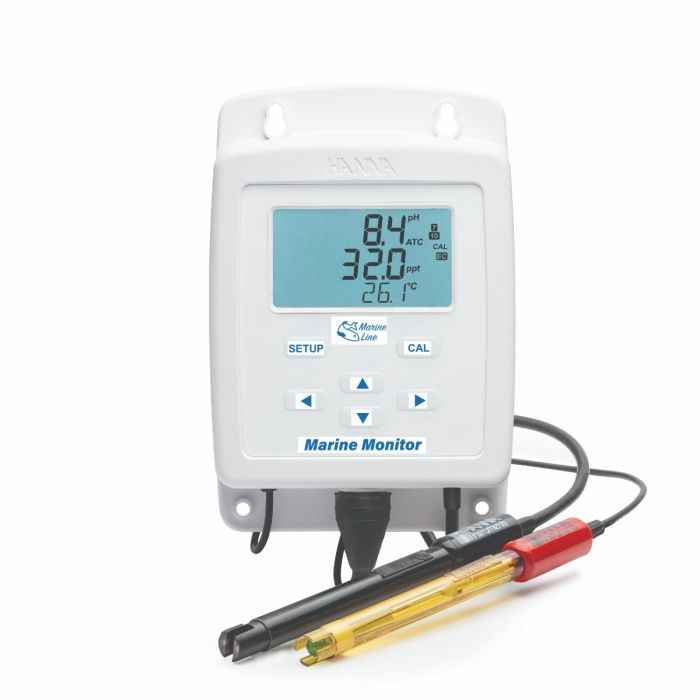Description
The HI981520 is an easy to use vertical mount unit that continuously monitors and displays conductivity and pH. The system can be calibrated at one or two points for pH and at one point for conductivity. Seawater salinity is expressed in either parts per thousand (ppt), Practical Salinity Units (PSU), or Specific Gravity (S.G.). A high/low alarm can be configured for each parameter and the results are displayed on a large, easy to read LCD. The attached two-electrode conductivity probe features a built-in temperature sensor for rapid, high-accuracy temperature readings.
The Hanna HI1286 pH double junction, gel filled pH electrode features a PEI resin body that is easy to clean and resistant to many aggressive chemicals. Additionally, the double junction design is less susceptible to clogging for fast and stable readings.
• Waterproof
• Automatic temperature compensation (ATC)
• Dual pin graphite EC probe
Package Contents
• HI981520 monitor with attached EC & temperature probe
• HI1286 replaceable pH electrode
• pH 7.01 buffer solution, 20 mL (2 sachets)
• pH 10.01 buffer solution, 20 mL (2 sachets)
• 35.00 ppt salinity calibration solution, 20 mL (2 sachets)
• Electrode cleaning solution, 20 mL (2 sachets)
• Suction cup (2 pieces)
• Self‑adhesive strip (2 pieces)
• 12 VDC power adapter
• pH electrode quality certificate
• Quick reference guide with instrument quality certificate
Main Features
• Two Alarm operating modes (High / Low Value) for each supported parameter
• High / Low Alarm generated when measured value exceeds or drops below configured parameter High / Low Value
• Acoustic signal generated each time an alarm is triggered
• EC probe contains an integral temperature sensor that simplifies installation
• All readings are compensated for variations in temperature
More features
Method and Parameter: Chosen parameter and method used is displayed along with the reading.
Dedicated Setup Key: A dedicated setup key allows users to quickly navigate to setup options.
Splash-proof Keypad: Intuitive on-screen menus are easy to navigate with the splash-proof keypad.
Power Supply: The 12 Vdc adapter (included) allows for continuous monitoring
Fixed EC probe: Built-in temperature sensor at the tip of the EC sensor allows for rapid determination of the sample temperature and a high-accuracy temperature reading.
Compact size: Measures 125 mm (4.92”) x 185 mm (7.28”) and only 38 mm (1.49”) thick.
Dedicated Calibration Key: A dedicated calibration key allows users to start a one or two-point pH and EC automatic calibration at the touch of a button.
Replaceable pH probe with BNC connection: The PEI resin body is easy to clean and resistant to many aggressive chemicals. The porous PTFE junction is equally resistant to aggressive chemicals. The double junction design presents a silver-free electrolyte solution interacting with the sample, making the electrode less susceptible to clogging and guaranteeing a fast response and stable reading.
Measuring Seawater Salinity
Choice of Units
Seawater salinity units can be chosen through the setup menu.
ppt
Measurements expressed in ppt are based on the Natural Seawater Scale that extends from 0.00 to 80.00 g/L and covers 10 to 31 °C temperature range. It determines the salinity based upon a conductivity ratio of sample to standard seawater at 15 °C and an approximate salinity value of 35 in seawater.
PSU
The practical salinity of seawater relates the ratio of electrical conductivity of a normal seawater sample at 15 °C and 1 atmosphere to a potassium chloride solution (KCl) with a mass of 32.4356 g/Kg water at the same temperature and pressure. Under these conditions the ratio is equal to 1 and S=35. The practical salinity scale may be applied to values 0 through 42.00 psu at temperatures between 0 to 35 °C.
Specific Gravity (S.G.)
Specific Gravity, or relative density, is expressed as the ratio of the density of seawater, at a specific temperature, relative to the density of the same volume of pure water at a specific temperature.
The probes are secured with suction cups to the back of an aquarium (tank) and are suited for continuous measurement of conductivity and associated parameters required in applications such as seawater, saltwater aquariums, or aquaculture.











